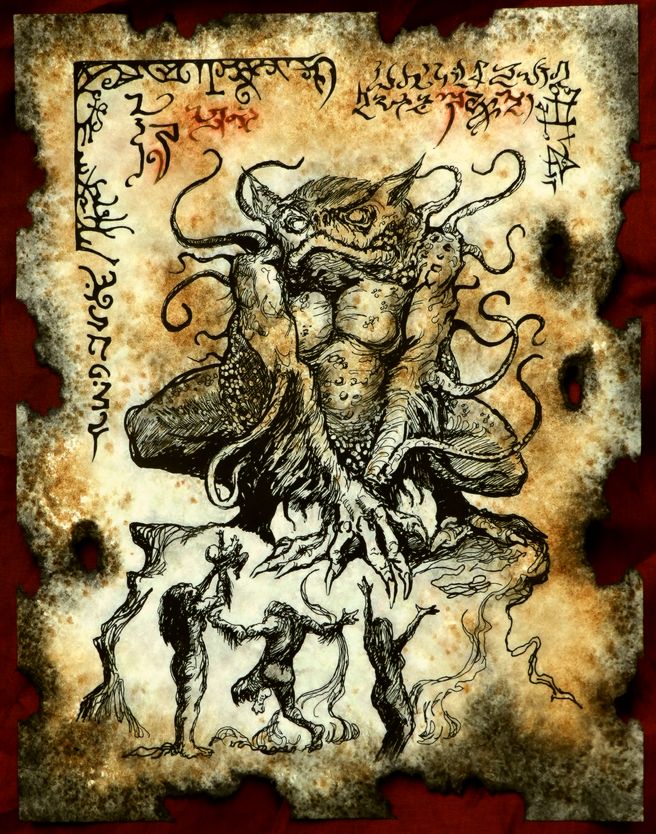 |
| Image by MrZarono. |
Last week's Team Tsathogga game ended with an epic battle, which we have - in a sense - been building up to since the game began. Driven in disorder from the subterranean snakeman base that they discovered last week, the PCs roamed from island to island, cashing in every favour they could think of in order to assemble a small army of allies with which to mount a new assault. Their motley brigade of slug-men, skeletons, press-ganged sailors, zombies, hunter-gatherers, tunnel-dwellers, and religious warriors, led by a whole gallery of NPC allies accumulated over the course of the game so far, attacked the snake-man base from two sides and ultimately managed to overwhelm its defences, in an epic battle which ended up involving laser guns and poisoned gas and black powder grenades and acidic ectoplasm. To my astonishment, all the PCs emerged from the slaughter alive, although in one case this was only due to some absurdly lucky dice-rolling. (Jack the Fighter will not die!) Their victory means that they are now the proud owners of a recently-depopulated snake-man science facility, and the de facto rulers of the Purple Islands.
Anyway, the battle was a meatgrinder. It made me appreciate the simplicity of the B/X combat rules, which made resolving the attacks of whole units of troops very nearly as quick as it would have been in an actual wargame - which, not coincidentally, is of course what basic D&D evolved out of in the first place. And it was great to see all the different connections and alliances which the PCs had built up over the last year of game-time finally prove their worth, collectively allowing the party to take on a force which would have wiped the floor with them if they'd tried to go in alone. Now the surviving villagers and soldiers and tunnel dwellers have bonded over their shared experience of murdering snake-men; and with almost all their monstrous inhabitants now dead, a new era of harmony may be dawning over the Purple Islands. It would almost be heart-warming, if it wasn't for the fact that the PCs are already talking about using all the snake-man eggs they found in cryogenic storage to breed a new race of brainwashed serpent-warriors loyal to them alone.
 |
| Image by JonBeanHastings. |
I started the Team Tsathogga game just as a way of easing myself back into gaming after a long absence, and as a way of introducing D&D to a bunch of new players with no prior experience of the game. I had no particular expectations of it, but it's actually been really successful. Looking back over the campaign to date, which has now taken the PCs from level 0 to level 4 over the course of sixty-odd hours of actual play, I have a few conclusions:
1: B/X D&D is a superb system for new players.
I kinda knew this anyway, but I'd never had an opportunity to put it to the test. But the fact that I was able to explain the rules, have the players create characters, and have the PCs entering the dungeon within about twenty minutes of starting the first session really cut down the barriers to entry. All the investigation of how things worked - how many hits it takes to kill a goblin, what armour class your cobbled-together leather armour grants, and so on - became things that the PCs figured out through actual play, rather than having everything front-loaded right at the start. If I'd been running in, say, Pathfinder, I think the players would have got bored and wandered off before I'd finished explaining half the available character-building options to them.
2: Having multiple characters per player can work really well.
This was never a deliberate plan on my part: I started each player off with three level 0 characters, on the assumption that most of them would die early on and the survivors would become the PCs. But this never actually happened: some died, yes, but most lived, and a few sessions in we'd stablised at two characters per player. I'd vaguely thought that if something like this happened, each player would pick one character to be a PC and the rest would become henchmen, but in fact everyone seemed pretty much equally attached to both their characters, so we just drifted into a two-PCs-per-player model.
This turned out to have loads of advantages. It meant that character death wasn't a big deal: you just carried on with your other PC until a chance arose to recruit a replacement. It meant that no-one minded too much about 'bad' ability scores, because your two characters could usually help cover one another's weaknesses. And it helped to lessen the problem of power disparity between casters and non-casters, because usually each player would have one caster PC and one non-caster PC, so the players were on an equal footing even if the characters weren't. I'd never try it with more complex systems - the thought of trying to run a Pathfinder game with 8-12 PCs is horrific - but B/X D&D is so simple that we really didn't find it difficult to deal with.
3: Random character generation is amazing.
I've written before about how rolling 3d6 in order will sometimes produce characters no-one would ever have thought of themselves, like Jack the Fighter (Str 5, Cha 18) and Sophie the Muscle Wizard (Str 16, Con 4, Int 10). But even in less extreme cases, it creates all kinds of odd, characterful little quirks: so Skadi is weak but tough, Circe is wise but ignorant and illiterate, Hash is much stronger than anyone expects him to be, and so on. Less random systems strongly discourage sub-optimal placement of ability scores, meaning that you lose out on the possibility of a character who just happens to be surprisingly strong, or unfit, or ugly, or whatever - not as part of some kind of complicated min-maxing strategy, but just because that's who they happen to be. Rolling randomly for hit points has a similar effect: the fact that Circe had only 4 HP at level 2 was a major reason why she tended to be so cowardly in dangerous situations, which has gone on to become a well-established part of her personality even though she's now almost four times as tough. It does mean that not all characters are equal in power, but the whole 'multiple PCs per player' does a lot to help with that.
4: There's no need for a skill system.
Everything from stealth to crafting to mountaineering has proven perfectly straightforward to handle simply through a combination of ability rolls and common sense. ('Well, you used to be an entertainer, so I guess you probably do know how to play the piano!') Randomly generated ability scores are heavily bell-curved around 10.5, so 'ability score or less on 1d20' is usually a perfectly good solution for cases where something could legitimately go either way, producing a good mix of successes and failures while also favouring characters who should logically be better at the task at hand. We don't use thieves, and honestly I haven't missed them in the least.
5: B/X characters are surprisingly durable.
Not at first level, of course. But by the time you're talking about, say, a fourth-level fighter with half-plate armour and 27 HP, they're honestly very difficult to bring down, able to endure five or six arrows or sword-wounds and still carry on fighting. If your party are in the habit of standing toe-to-toe with the monsters and exchanging blows until someone falls over, I can see that accumulating that many injuries might actually happen. But my PCs are a devious bunch, whose reaction to finding themselves in anything like a fair fight is always to run away and not come back until they've engineered an unfair advantage; they usually disengage as soon as they start taking real damage, and as a result, ever since they progressed past the point where a PC could be randomly taken out by a stray arrow it's proven surprisingly difficult to kill the bastards. Even Death Frost Doom only put paid to one of them.
6: Balancing casters is hard.
The traditional assumption is that the low-level B/X caster is a feeble creature, because they only get one or two spells per day, and aren't much good in a fight; but this assumes a dungeon context, in which once you're through the front doors, you have very limited control over how many encounters you might have to endure before you get a chance to rest. Given that this game largely consisted of me drawing big overland maps on a whiteboard and asking the players where they wanted to go next, the same resource economy didn't really apply; one or two 'encounters' per game-day was the norm, and most of those were resolved non-violently. Under those circumstances, there was little to prevent casters loading up with new spells for each situation; and as a result, by level 3 or so it was hard to feel that they weren't the ones doing most of the work. The multiple characters thing worked in our favour here, as most players had one caster and one non-caster character, so balance between players was maintained even if balance between characters wasn't. But it's definitely something I'm going to need to think about how to address in future, as it's only going to become more of a problem as they level up...
Anyway, the game's now on hiatus, but we'll probably play a few more sessions after Easter. They've come a long way from their humble origins, and I'm keen to see how much further they'll manage to get!
I might even ultimately bring them to the Wicked City...
So happy to hear that everything is going so well! I'm having a similar experience with my new game that I wrote about a few weeks ago. You do a great job with these play reports, they really are fun to read.
ReplyDeleteAnd what a teaser, I'd really like to read about their play in the Wicked City!